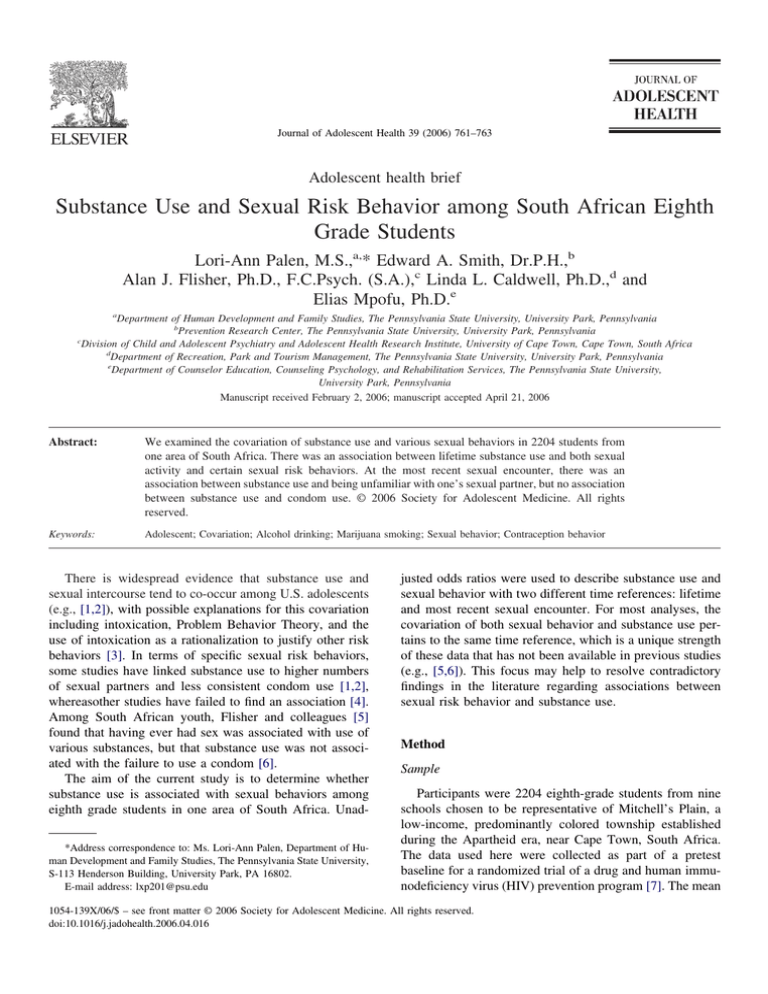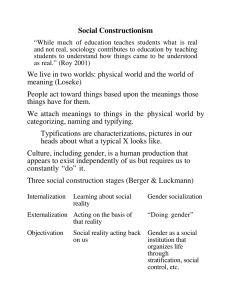
Journal of Adolescent Health 39 (2006) 761–763
Adolescent health brief
Substance Use and Sexual Risk Behavior among South African Eighth
Grade Students
Lori-Ann Palen, M.S.,a,* Edward A. Smith, Dr.P.H.,b
Alan J. Flisher, Ph.D., F.C.Psych. (S.A.),c Linda L. Caldwell, Ph.D.,d and
Elias Mpofu, Ph.D.e
a
Department of Human Development and Family Studies, The Pennsylvania State University, University Park, Pennsylvania
b
Prevention Research Center, The Pennsylvania State University, University Park, Pennsylvania
c
Division of Child and Adolescent Psychiatry and Adolescent Health Research Institute, University of Cape Town, Cape Town, South Africa
d
Department of Recreation, Park and Tourism Management, The Pennsylvania State University, University Park, Pennsylvania
e
Department of Counselor Education, Counseling Psychology, and Rehabilitation Services, The Pennsylvania State University,
University Park, Pennsylvania
Manuscript received February 2, 2006; manuscript accepted April 21, 2006
Abstract:
We examined the covariation of substance use and various sexual behaviors in 2204 students from
one area of South Africa. There was an association between lifetime substance use and both sexual
activity and certain sexual risk behaviors. At the most recent sexual encounter, there was an
association between substance use and being unfamiliar with one’s sexual partner, but no association
between substance use and condom use. © 2006 Society for Adolescent Medicine. All rights
reserved.
Keywords:
Adolescent; Covariation; Alcohol drinking; Marijuana smoking; Sexual behavior; Contraception behavior
There is widespread evidence that substance use and
sexual intercourse tend to co-occur among U.S. adolescents
(e.g., [1,2]), with possible explanations for this covariation
including intoxication, Problem Behavior Theory, and the
use of intoxication as a rationalization to justify other risk
behaviors [3]. In terms of specific sexual risk behaviors,
some studies have linked substance use to higher numbers
of sexual partners and less consistent condom use [1,2],
whereasother studies have failed to find an association [4].
Among South African youth, Flisher and colleagues [5]
found that having ever had sex was associated with use of
various substances, but that substance use was not associated with the failure to use a condom [6].
The aim of the current study is to determine whether
substance use is associated with sexual behaviors among
eighth grade students in one area of South Africa. Unad*Address correspondence to: Ms. Lori-Ann Palen, Department of Human Development and Family Studies, The Pennsylvania State University,
S-113 Henderson Building, University Park, PA 16802.
E-mail address: lxp201@psu.edu
justed odds ratios were used to describe substance use and
sexual behavior with two different time references: lifetime
and most recent sexual encounter. For most analyses, the
covariation of both sexual behavior and substance use pertains to the same time reference, which is a unique strength
of these data that has not been available in previous studies
(e.g., [5,6]). This focus may help to resolve contradictory
findings in the literature regarding associations between
sexual risk behavior and substance use.
Method
Sample
Participants were 2204 eighth-grade students from nine
schools chosen to be representative of Mitchell’s Plain, a
low-income, predominantly colored township established
during the Apartheid era, near Cape Town, South Africa.
The data used here were collected as part of a pretest
baseline for a randomized trial of a drug and human immunodeficiency virus (HIV) prevention program [7]. The mean
1054-139X/06/$ – see front matter © 2006 Society for Adolescent Medicine. All rights reserved.
doi:10.1016/j.jadohealth.2006.04.016
762
L. Palen et al. / Journal of Adolescent Health 39 (2006) 761–763
Table 1
Associations between lifetime substance use and sexual behaviors
Sexual behavior
Substance users %
(95% CI) (n ⫽ 1021)a
Nonusers %
(95% CI) (n ⫽ 1155)a
Unadjusted odds ratio
(95% CI)
Lifetime sexual intercourse
Consistent condom useb (100% in lifetime)
Sporadic condom useb (25–75% in lifetime)
No condom useb (0% in lifetime)
Multiple partners in past 6 monthsb
19 (16–21)
48 (41–55)
39 (32–45)
13 (8–18)
40 (33–47)
5 (4–7)
56 (44–69)
22 (11–32)
22 (11–32)
20 (10–30)
3.9 (2.9–5.3)
.7 (.4–1.3)
2.2 (1.2–4.4)
.5 (.3–1.1)
2.6 (1.3–5.1)
a
b
22 participants had incomplete data on lifetime substance use.
Among those participants who have ever had sexual intercourse (n ⫽ 257).
age of all participants was 14.0 years (SD ⫽ .86). Fifty-one
percent of the sample was female. Most participants were
Coloured (derived from Asian, European, and African ancestry; 86%), with the rest of the students being Black (9%),
White (4%), or Other (1%).
Procedure
This study was approved by the Institutional Review
Boards of both the Pennsylvania State University and Stellenbosch University. Passive parental consent and adolescent assent procedures were employed. In total, about 3% of
eligible adolescents (n ⫽ 81) did not participate in the study
due to a refusal of consent or assent.
Participants completed assessments on hand-held personal digital assistants (PDAs). About 5% of eligible adolescents (n ⫽ 132) did not complete the survey due to
repeated school absences.
sexual intercourse (Table 1). There was also an association
between substance use and certain sexual risk behaviors.
Sexually active youth who had used alcohol and/or marijuana in their lifetimes were more likely to report sporadic
condom use (25% to 75% of the times they have had sex),
and more likely to report having had multiple sexual partners in the preceding six months.
In terms of their most recent sexual encounter (Table 2),
youth who used alcohol or marijuana during that event were
as likely to use condoms as youth who had not used these
substances. However, youth who used alcohol or marijuana
during their last sexual encounter were more likely to have
just met their partner. Although there were some significant
gender differences in the odds ratios reported here, the
direction of all findings remained the same for boys and
girls.
Measures
Discussion
Standard measures of lifetime substance use [5,6] were
used to create a dichotomous substance use variable indicating whether participants had ever used alcohol and/or
marijuana. Participants also indicated whether they had ever
had vaginal sexual intercourse; those who had were presented with questions about general sexual history (frequency of condom use, number of sexual partners in the
preceding six months) and their most recent sexual encounter (condom use, relationship to partner, use of alcohol or
marijuana, rationale for and consequences of this substance
use).
The association found between lifetime sexual intercourse and substance use mirrors the results of numerous
studies of these behaviors among samples of adults and
adolescents in the United States and Africa [1–3,5,8,9].
Lifetime substance use was also associated with greater
likelihoods of inconsistent condom use and having multiple
sexual partners.
Analyses of the covariation between sexual behaviors
and substance use at last sexual intercourse provide a more
Results
In total, 12% of the sample reported having had sexual
intercourse in their lifetime. During their most recent sexual
encounter, 39% of these adolescents reported using alcohol
or marijuana. Among those who used these substances, 23%
reported that substances influenced their decision to have
sex, and 26% reported using substances in order to feel
more comfortable with their partner.
Youth who had ever used alcohol or marijuana in their
lifetime were significantly more likely to have ever had
Table 2
Associations between substance use and sexual behaviors at most recent
sexual encounter
Sexual behavior
Substance users %
(95% CI)
(n ⫽ 100)a
Nonusers %
(95% CI)
(n ⫽ 158)a
Unadjusted
odds ratio
(95% CI)
Condom use at last
sexual encounter
Just met partner at
last sexual
encounter
67 (58–76)
69 (62–76)
.9 (.5–1.6)
36 (27–46)
20 (13–26)
2.3 (1.3–4.2)
a
Two participants did not report lifetime sexual intercourse but did
report substance use at last intercourse; one sexually active participant did
not report on substance use at last intercourse.
L. Palen et al. / Journal of Adolescent Health 39 (2006) 761–763
precise investigation into the relations between these behaviors [3]. Youth who used substances at their last sexual
encounter were as likely to use a condom at that encounter
as youth who had not been using substances. Although this
may seem inconsistent with the above-mentioned association between lifetime substance use and sporadic condom
use, it is highly possible that lifetime reports of sex, condom
use, and substance use refer to a number of unrelated events
during which only one of these behaviors occurred. Also,
the odds ratio for condom use at the most recent sexual
encounter is consistent with what has been found in diary
studies with U.S. samples [4,10]. Consequently, this finding
is both plausible and important to consider when promoting
risk prevention. We also found that youth who were using
alcohol or marijuana at their most recent sexual encounter
were more likely to have just met their partner that same
day. This makes sense in light of the fact that many of the
adolescents in the current sample report that they used
substances to feel more comfortable with a sexual partner.
Pragmatically, these findings suggest that interventions
may be more effective if they increase their emphasis on the
role of substances in casual sex rather than stressing direct
links between substance use and failure to use a condom.
Programs that emphasize to youth that substance use will
lead to nonuse of condoms may be sending a false message,
or, at least, a message that some youth will dismiss. Alternatively, program messages may want to focus on the association between substance use and the increased likelihood of having sex with someone you do not know. This
message, combined with a message that such “hooking-up”
encounters are ripe for the transmission of HIV and other
sexually transmitted infections, may be a more salient way
of increasing consistency in condom use.
763
Acknowledgment
This research was supported by National Institutes of
Health Grant R01 DA01749.
References
[1] Lowry R, Holtzman D, Truman BI, et al. Substance use and HIVrelated sexual behaviors among US high school students: are they
related? Am J Public Health 1994;84:1116 –20.
[2] Tapert SF, Aarons GA, Sedlar GR, et al. Adolescent substance use
and sexual risk-taking behavior. J Adolesc Health 2001;28:181–9.
[3] Leigh BC, Stall R. Substance use and risky sexual behavior for
exposure to HIV: issues in methodology, interpretation, and prevention. Am Psychol 1993;48:1035– 45.
[4] Morrison DM, Gillmore MR, Hoppe MJ, et al. Adolescent drinking
and sex: findings from a daily diary study. Perspect Sex Reprod
Health 2003;35:162– 8.
[5] Flisher AJ, Ziervogel CF, Chalton DO, et al. Risk-taking behaviour of Cape Peninsula high-school students: Part IX. Evidence for
a syndrome of adolescent risk behaviour. S Afr Med J 1996;86:
1090 –3.
[6] Flisher AJ, Chalton DO. Adolescent contraceptive non-use and
covariation among risk behaviors. J Adolesc Health 2001;28:235–
41.
[7] Caldwell L, Smith E, Wegner L, et al. HealthWise South Africa:
development of a life skills curriculum for young adults. World Leis
2004;3:4 –17.
[8] Taffa N, Klepp KI, Sundby J, et al. Psychosocial determinants of
sexual activity and condom use intention among youth in Addis
Ababa, Ethiopia. Int J STD AIDS 2002;13:714 –9.
[9] Simbayi LC, Kalichman SC, Jooste D, et al. Alcohol use and sexual
risks for HIV infection among men and women receiving sexually
transmitted infection services in Cape Town, South Africa. J Stud
Alcohol 2004;65:434 – 42.
[10] Leigh BC. Alcohol consumption and sexual activity as reported with
a diary technique. J Abnorm Psychol 1993;102:490 –3.





